|
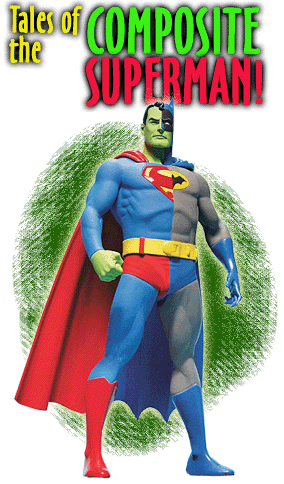 I
guess you had to be there. Comic-reading kids
of today, "sophisticated" party-poopers that they
are, would take one look at the Composite Superman and declare
him the dumbest villain ever created. And yet when kids
in the mid-60s saw this same figure streaking across the
cover of World's Finest Comics No. 142, they knew
immediately he'd be one of the greatest. I
guess you had to be there. Comic-reading kids
of today, "sophisticated" party-poopers that they
are, would take one look at the Composite Superman and declare
him the dumbest villain ever created. And yet when kids
in the mid-60s saw this same figure streaking across the
cover of World's Finest Comics No. 142, they knew
immediately he'd be one of the greatest.
The funny thing is, both judgements are based on the same
thing: the unforgettably weird image of a green-skinned
man wearing a costume literally split down the middle; Superman
on the left side, Batman on the right. Just the sort of
thing guaranteed to generate sales in the 60s, and laughter
today.
Whatever you may have thought of Compy's sartorial sense,
however, there was nothing remotely funny about the guy
himself. Wrapped up in that oddball outfit was a being of
godlike power who dedicated his near-omnipotence to venal,
selfish malevolence. In short, he was our heroes' worst
nightmare come to life.
The Composite Superman was, in reality, Joe Meach, an embittered
nobody with a grudge against the world in general and superheroes
in particular. Through a freak accident, he finds himself
embued with the powers of (what was then) the entire Legion
of Super-Heroes, and able at last to take out his resentment
against humanity.
After years of watching the World's Finest team mop up
the floor with two-bit gangsters and mad scientists and
the occasional alien monster, the Composite Superman was
a revelation: an enemy who presented a genuine challenge,
and then some. The burning question on the minds of young
readers was how...how could Superman and Batman possibly
defeat a villain with the strength of Supergirl, Ultra-Boy
and Mon-El, any one of them a near-match for Superman? Not
to mention an adversary who, aside from that super strength
and speed, could also grow to giant size, hurl lightning
bolts and fireballs, turn invisible, walk through walls,
change the elements with a mere gesture, read our heroes'
minds or disguise himself as any being or object? And as
an ultimate "ace in the hole," he could always
multiply himself from one man into three, each as powerful
as the others.
The answer was even more of a shocker...our heroes couldn't
defeat him! In the Composite Superman, the invincible team
of Superman and Batman met defeat not once, but twice. A
first battle left our heroes with a character-building taste
of humility. The second found them no better off, though
it ultimately ended in one of those wonderful Silver Age
re-affirmations of the basic decency that can lurk in even
the darkest hearts.
As a kid, these stories had a profound impact on me. Among
my earliest doodlings are images of a strange fellow with
a Superman spit curl and a singe Bat-ear. Even now I sometimes
find myself absent-mindedly drawing the guy. And I'm probably
not the only fan who's considered collecting the entire
line of DC Direct "Legion" action figures, just
in case a stray lightning bolt might come along to grant
me incalculable power.
Below I've provided links to the first and second appearances
of the Composite Superman, so you can meet the guy for yourself.
Corny? Sure. Goofy-looking? Maybe. But definitely unforgettable.
And for the record, the one baddie who came the closest
to cashing in Superman's chips.
"The
Composite Superman!"
World's Finest No. 142
Cover Date: June 1964
Written By: Edmund Hamilton
Pencils: Curt
Swan
Inks: Sheldon Moldoff
One of the recurring themes in DC's Silver
Age was that character is ultimately more important than
power. Even in stories where Superman's powers were taken
away, his courage and resourcefulness still ensured his
victory. Yet as we often saw, if a man was evil, even gaining
powers far beyond those of ordinary men wouldn't help him
prevail; ultimately his weakness of character guaranteed
his defeat.
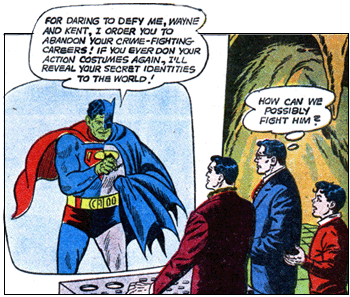 Joe
Meach is a perfect example. A perennial loser intent on
blaming anyone but himself for his many failures, Joe is
accidentally transformed into the most powerful being in
the Universe and immediately starts to squander his powers
seeking glory and vengeance. Even as a revenge-driven marauder
he proves a failure, since his powers have a time limit
and he wastes that time humiliating the World's Finest team
rather than simply killing them outright. The Composite
Superman may stand as the most powerful character in comics'
history, but he's undone by the man within...childish, petulant
Joe Meach. Joe
Meach is a perfect example. A perennial loser intent on
blaming anyone but himself for his many failures, Joe is
accidentally transformed into the most powerful being in
the Universe and immediately starts to squander his powers
seeking glory and vengeance. Even as a revenge-driven marauder
he proves a failure, since his powers have a time limit
and he wastes that time humiliating the World's Finest team
rather than simply killing them outright. The Composite
Superman may stand as the most powerful character in comics'
history, but he's undone by the man within...childish, petulant
Joe Meach.
A persistent complaint among critics of World's Finest
Comics was that Batman was hopelessly outclassed by
Superman in terms of power. Why, they ask, would the most
powerful hero on Earth ever need the help of the one "superhero"
who has no powers at all? This story brings that issue to
the forefront: a fight between the Caped Crusader and the
Composite Superman is roughly equivalent to one between
George Foreman and an Intercontinental Ballistic Missile.
But in a way, this story may also answer the age-old questioning
of Batman's worth. For all his abilities, Superman in this
story is every bit as ineffectual as Batman, so the playing
field is levelled to some extent. In keeping with the story's
theme that a man's character is paramount, here Batman's
keen mind and undaunted courage make him a match for Superman
in every way that counts.
Some may read this story
and wonder how it made my "greatest" list. After
all, Superman is thwarted at every turn and does not enjoy
a decisive victory. In fact at best you might say he merely
survives. But I think in its own way this near-defeat says
more about our hero than all his triumphs. "Doing the
right thing" is relatively easy when the odds are on
your side, but facing overwhelming odds with no guarantee
of success takes true courage. As many mere mortals of history
have shown, a true hero will continue the good fight even
when all hope of victory is gone.
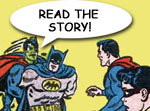
"The
Return of the Composite Superman!"
World's Finest No. 168
Cover Date: Aug. 1967
Written By: Cary Bates
Pencils: Curt
Swan
Inks: George Klein
Several years after the Composite Superman's
memorable debut, young writer Cary Bates resurrected the
villain for this follow-up tale. We see that Joe Meach's
time spent in honest hard work at the Superman Museum have
had a wonderful effect on the guy...now he's a decent fellow
with a fond respect for our heroes. Unfortunately, fickle
fate isn't finished with poor old Joe and before long he
finds himself taken over again by his less charming alter-ego.
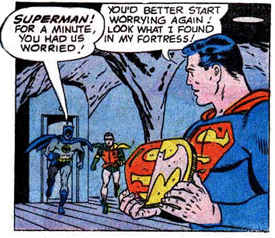 This
time out a mysterious third party is pulling the strings,
though for most of the story it makes little difference.
Just as before, Superman and Batman find themselves out-powered,
out-maneuvered and outdone by the half-and-half villain,
and once again it takes a miracle of luck to save their
bacon. Again character proves vital as help comes from the
most unexpected source of all, and the saga of the Composite
Superman comes full circle with a reaffirmation that good
will always win out over evil. This
time out a mysterious third party is pulling the strings,
though for most of the story it makes little difference.
Just as before, Superman and Batman find themselves out-powered,
out-maneuvered and outdone by the half-and-half villain,
and once again it takes a miracle of luck to save their
bacon. Again character proves vital as help comes from the
most unexpected source of all, and the saga of the Composite
Superman comes full circle with a reaffirmation that good
will always win out over evil.
Years later, the alien character in this story would himself
become a new version of the Composite Superman, but for
all intents and purposes it is these two appearances by
the Joe Meach model that really count. The only lingering
question is why would the Superman Museum even have statues
of the Legion of Super-Heroes? What museum commemorates
adventures that haven't even happened yet, as far as history
is concerned? No one in our century should even know who
the Legionnaires are. And if they do, wouldn't the wide-spread
foreknowledge of future events endanger Legion history from
unfolding as it should?
As a final note, you'll see that in the
years between the two stories, the Batman TV show has gone
on the air. Dead give-aways here include a reference to
the Bat-phone, Robin's exclamation of "Holy Triple
Vision!" and a lecture from Batman on the importance
of wearing seat belts.
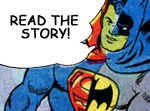
|

 I
guess you had to be there. Comic-reading kids
of today, "sophisticated" party-poopers that they
are, would take one look at the Composite Superman and declare
him the dumbest villain ever created. And yet when kids
in the mid-60s saw this same figure streaking across the
cover of World's Finest Comics No. 142, they knew
immediately he'd be one of the greatest.
I
guess you had to be there. Comic-reading kids
of today, "sophisticated" party-poopers that they
are, would take one look at the Composite Superman and declare
him the dumbest villain ever created. And yet when kids
in the mid-60s saw this same figure streaking across the
cover of World's Finest Comics No. 142, they knew
immediately he'd be one of the greatest. Joe
Meach is a perfect example. A perennial loser intent on
blaming anyone but himself for his many failures, Joe is
accidentally transformed into the most powerful being in
the Universe and immediately starts to squander his powers
seeking glory and vengeance. Even as a revenge-driven marauder
he proves a failure, since his powers have a time limit
and he wastes that time humiliating the World's Finest team
rather than simply killing them outright. The Composite
Superman may stand as the most powerful character in comics'
history, but he's undone by the man within...childish, petulant
Joe Meach.
Joe
Meach is a perfect example. A perennial loser intent on
blaming anyone but himself for his many failures, Joe is
accidentally transformed into the most powerful being in
the Universe and immediately starts to squander his powers
seeking glory and vengeance. Even as a revenge-driven marauder
he proves a failure, since his powers have a time limit
and he wastes that time humiliating the World's Finest team
rather than simply killing them outright. The Composite
Superman may stand as the most powerful character in comics'
history, but he's undone by the man within...childish, petulant
Joe Meach.

